19 Best Desert Landscaping Plants for Nevada
BY MELANIE JOSEPH | MAY 25TH, 2023 | LAWN CARE, NEVADANevada, known as the Silver State, is famous for its vibrant Las Vegas casinos, luxurious hotels, and bright lights. It’s also known for its desert landscapes that stretch as far as the eye can see. With its arid climate and scorching temperatures, it’s no surprise that many homeowners in Nevada are turning to desert gardening to transform their outdoor spaces. But finding the right plants for this harsh environment can be a challenge.
Fortunately, these 19 best desert landscaping plants for Nevada can thrive in the state’s climate and add beauty and interest to any landscape. From the iconic Joshua tree to the stunning creosote bush, there are plenty of options to choose from. Whether you’re looking to create a lush oasis or a minimalist xeriscape, these plants are sure to inspire and bring a touch of desert magic to your own backyard.
In this article, we’ll cover:
- 19 Best Desert Landscaping Plants for Nevada
- What Makes a Plant Good for the Desert?
- FAQ About the Best Desert Landscaping Plants for Nevada
19 Best Desert Landscaping Plants for Nevada
The following drought-resistant plants can tolerate Nevada’s unique climate while also beautifying and adding character to any garden:
1. Blue Palo Verde (Parkinsonia florida)
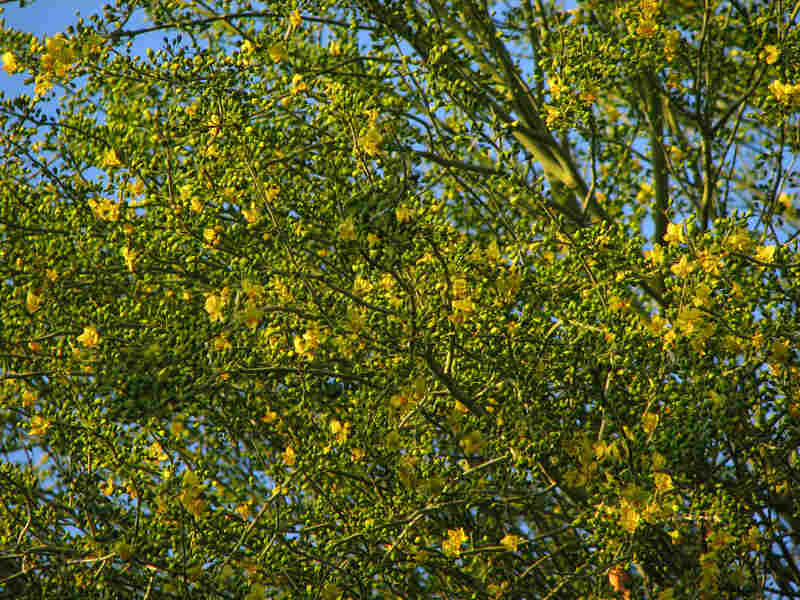
Photo Credit: Katja Schulz from Washington, D. C., USA / Wikimedia Commons / CC BY 2.0
Native to the Southwest, including California, Arizona, New Mexico, and parts of Nevada, blue palo verde is a stunning desert tree highly recommended for homeowners in Southern Nevada. It also can grow in Northern Nevada, although it is less commonly planted in gardens in this region.
With a smooth, green bark and tiny, wispy leaves that are almost invisible to the naked eye, this perennial tree blooms in the spring and produces striking yellow flowers that add color to any landscape. Its fruits are small, brown pods that split open to release seeds, which can be used to propagate new plants.
This low-maintenance plant requires little water once established, making it an ideal choice for homeowners looking for a water-wise landscaping option. The best time to plant blue palo verde is in the fall or winter – when the plant is dormant, and the temperatures are cooler. Consider underplanting it with low-growing, drought-tolerant plants like agave or desert marigold.
Growth habit: Tree
USDA Hardiness Zone: 8-11
Mature size: 20-25 feet tall, 15-20 feet wide
Duration: Perennial
Foliage: Deciduous
Sunlight needs: Full sun
Soil preferences: Prefers slightly alkaline, sandy, loam, well-drained soil
Water needs: Low
Potential hazards: Non-toxic – but its bark and twigs are covered in small thorns, which can cause injury if not handled carefully
2. Brittlebush (Encelia farinosa)
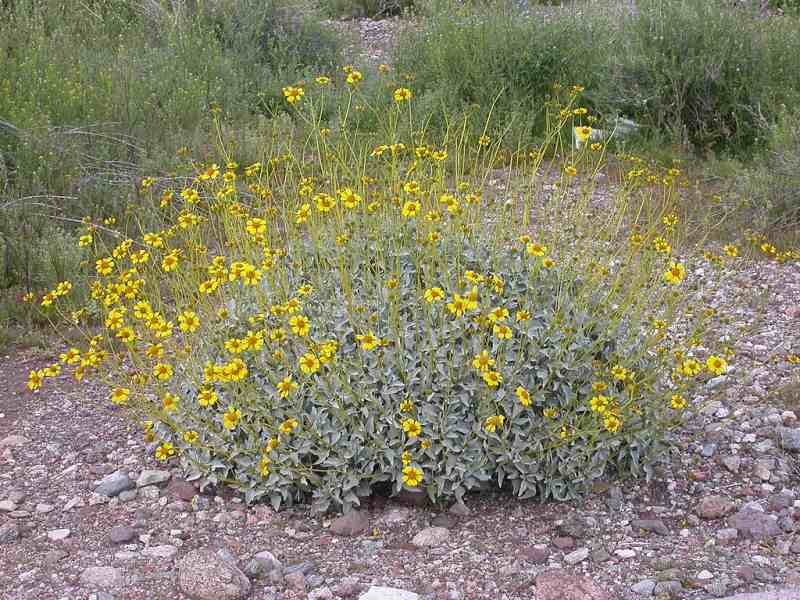
Photo Credit: Copyright by Curtis Clark, licensed as noted / Wikimedia Commons / CC BY-SA 2.5
Often found growing in the high desert regions of Nevada, brittlebush has silver-gray leaves covered in fine hairs to reflect the sun’s heat. Its yellow daisy-like flowers bloom from February to May, making it an early spring bloomer that attracts various pollinators, including bees, butterflies, and hummingbirds.
It produces small, brown, triangular-shaped seeds that are dispersed by the wind and can be used to propagate new plants. The best time to plant brittlebush is in the fall or early spring, as it can be sensitive to frost.
This drought-tolerant plant is highly resistant to pests and diseases. And although it’s not poisonous to humans or animals, its leaves and stems are covered in small, sharp hairs that can irritate the skin, so you must wear gloves when handling it.
Also, note that its leaves contain a water-soluble substance that inhibits the growth of certain winter annual plants, indicating its allelopathic nature. Moreover, it competes with buffalograss, which can affect the survival of both species in the same area.
Growth habit: Shrub
USDA Hardiness Zone: 8-11
Mature size: 2-4 feet tall and 2-4 feet wide
Duration: Perennial
Foliage: Evergreen – but deciduous after extreme drought or frost
Sunlight needs: Full sun
Soil preferences: Well-drained, sandy, or loamy soil
Water needs: Low
Potential hazards: Non-toxic
3. Creosote bush (Larrea tridentata)
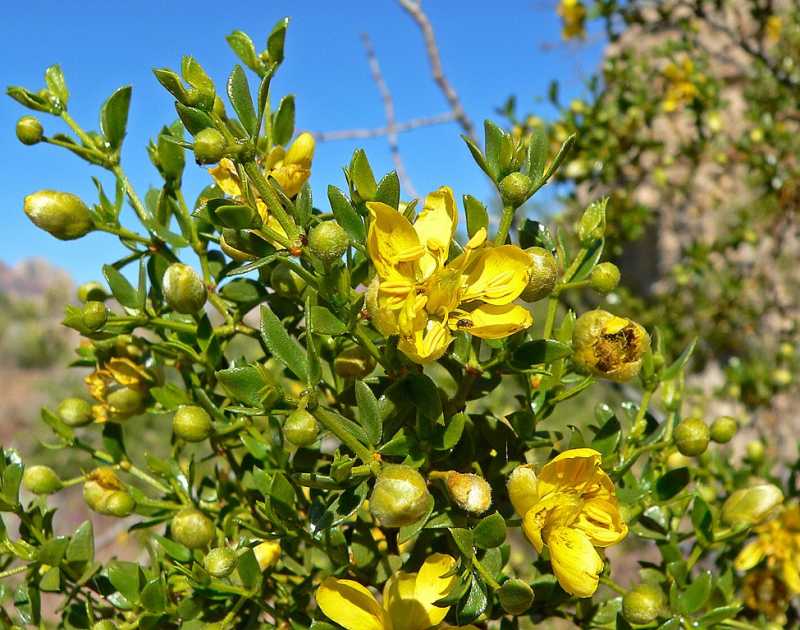
Photo Credit: Stan Shebs / Wikimedia Commons / CC BY-SA 3.0
A hardy and resilient desert plant, creosote bush is well-suited for gardens in Nevada. This deer-resistant plant can be found growing throughout the state, especially in the Mojave and Sonoran deserts.
This evergreen shrub features small, waxy leaves that give off a distinct aroma when crushed. Its yellow flowers bloom in the summer and spring, creating a striking contrast against the backdrop of the arid desert landscape and attracting bees and other pollinators. These flowers give way to fluffy, white seed heads that can be propagated to create new plants.
The best time to plant creosote bush is in the fall. Once established, this drought-tolerant plant has low water needs, making it an excellent choice for water-wise gardens. You also can underplant it with other desert-friendly plants, such as brittlebush, desert marigold, or firecracker penstemon.
Growth habit: Shrub
USDA Hardiness Zone: 7-11
Mature size: 4-8 feet tall and 4-8 feet wide
Duration: Perennial
Foliage: Evergreen
Sunlight needs: Full sun
Soil preferences: Prefers well-drained, loamy, or sandy soil but can thrive even in dry and rocky soil
Water needs: Low
Potential hazards: Toxic to both humans and animals – plus, its leaves and branches are covered in a resinous coating that can cause skin irritation in some people.
4. Date Palm (Phoenix dactylifera)
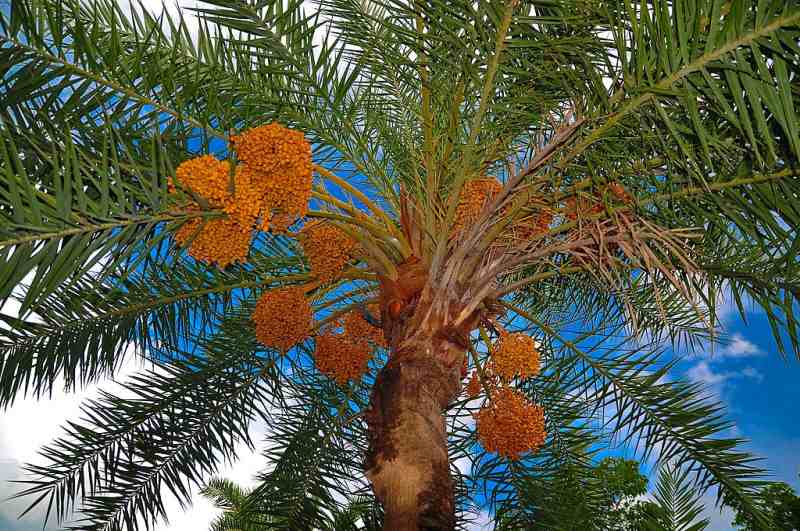
Photo Credit: Balaram Mahalder / Wikimedia Commons / CC BY-SA 3.0
While date palms are typically found in the warmer regions of Southern Nevada, they also can grow well in other regions throughout Nevada with proper care. These palm trees have been cultivated for their sweet, nutritious fruit for thousands of years. In Nevada, they are commonly planted in residential and commercial landscapes, especially in areas with a Mediterranean climate.
Date palms have long, slender fronds with a blue-green color that adds a tropical feel to any landscape. This evergreen tree typically blooms in late winter or early spring, producing small yellowish-white flowers that give way to clusters of edible, oval-shaped dates ranging in color from golden yellow to dark brown, depending on the ripeness.
Growth habit: Palm tree or cycad
USDA Hardiness Zone: 9-11
Mature size: 50-80 feet tall
Duration: Perennial
Foliage: Evergreen
Sunlight needs: Full sun
Soil preferences: Well-drained, loamy, clay, chalk, or sandy soil
Water needs: Low
Potential hazards: Slightly toxic – its thorns are poisonous and may cause injuries
5. Desert Bluebell (Phacelia campanularia)
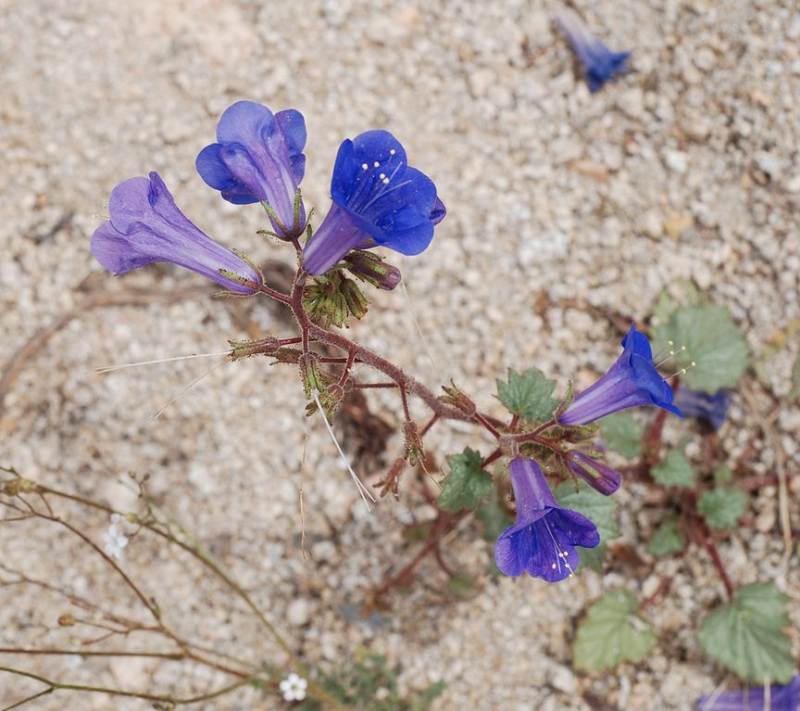
Photo Credit: Jarek Tuszyński / CC-BY-SA-3.0 / Wikimedia Commons / CC BY-SA 3.0
Native to the Southwest, desert bluebell thrives in arid conditions, making it a perfect fit for the dry climate of Nevada. It’s best suited for gardens in Southern Nevada, including the Las Vegas Valley and the Mojave Desert, but it also can grow well in other regions with well-draining soil and full sun exposure.
With finely textured and bright green foliage, this small, annual wildflower blooms from March to May and produces vibrant blue, bell-shaped flowers that attract pollinators such as bees and butterflies.
This evergreen shrub is generally low-maintenance, drought-tolerant, and does not require much water once established. Plus, it is highly resistant to diseases and pests. Desert bluebells are excellent for rock gardens, mixed borders, patios, and containers.
Growth habit: Wildflower
USDA Hardiness Zone: 5-10
Mature size: 6-24 inches tall
Duration: Annual
Foliage: Evergreen
Sunlight needs: Full sun
Soil preferences: Grows in dry soil but prefers well-drained, chalk, sandy, or loamy soil
Water needs: Low
Potential hazards: Toxic – all parts of the plant are poisonous to humans and animals
6. Desert Holly (Atriplex hymenelytra)
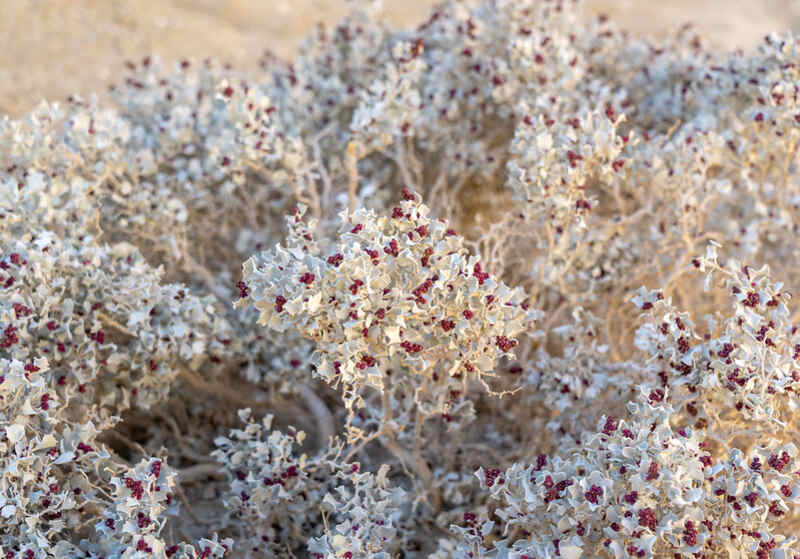
Photo Credit: A S / Flickr / CC BY 2.0
A good candidate for xeriscaping in Nevada, desert holly is a beautiful and resilient desert plant that can tolerate various temperatures and soil types. It’s native to the Southwest and can be found in areas like the Mojave Desert and the Great Basin. You’ll find it commonly planted in cities like Las Vegas and Reno.
Desert holly has a unique appearance with spiky, silvery-green leaves that shimmer in the sunlight. This small, perennial plant is evergreen in warmer climates but may lose its leaves during colder winters. It blooms in the late spring and summer and produces small, inconspicuous greenish-yellow flowers.
With its silvery foliage and spiky appearance that makes it stand out among other desert plants, this drought-tolerant plant doesn’t require much watering. It also can tolerate high alkalinity.
Growth habit: Shrub
USDA Hardiness Zone: 8-10
Mature size: 2-5 feet tall
Duration: Perennial
Foliage: Evergreen
Sunlight needs: Full sun
Soil preferences: Dry, well-drained, stony, or sandy soil
Water needs: Low
Potential hazards: Toxic
7. Desert Marigold (Baileya multiradiata)
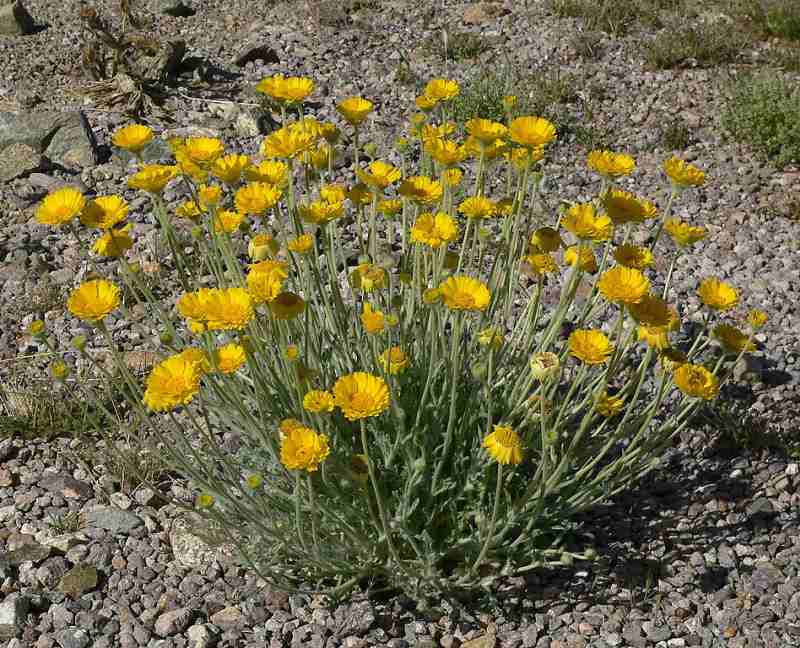
Photo Credit: Stan Shebs / Wikimedia Commons / CC BY-SA 3.0
With its natural habitat being in the Mojave Desert, this short-lived perennial is best suited for gardens in Southern Nevada. It blooms from February to November, producing vibrant yellow flowers that attract pollinators like bees and butterflies. Along with the plant’s fern-like leaves that have a soft texture and blue-green color, these daisy-like flowers can add a pop of color to any desert garden.
This flowering plant is deer-resistant and can thrive even in dry soil. Plus, it’s drought-tolerant and requires low water, making it an ideal choice for desert landscaping. To make it more beautiful in your garden, deadhead the spent flowers regularly to promote continuous blooming. Additionally, pruning it back in the fall can help it maintain its shape and keep it looking healthy.
Growth habit: Wildflower
USDA Hardiness Zone: 7-10
Mature size: 1-2 feet tall and 2-3 feet wide
Duration: Short-lived perennial or biennial
Foliage: Evergreen
Sunlight needs: Full sun
Soil preferences: Prefers well-drained, moist, clay, sandy, or loamy soil
Water needs: Low – once a month watering once established
Potential hazards: Highly toxic, especially to sheep and goats
8. Desert Sage (Salvia dorrii)
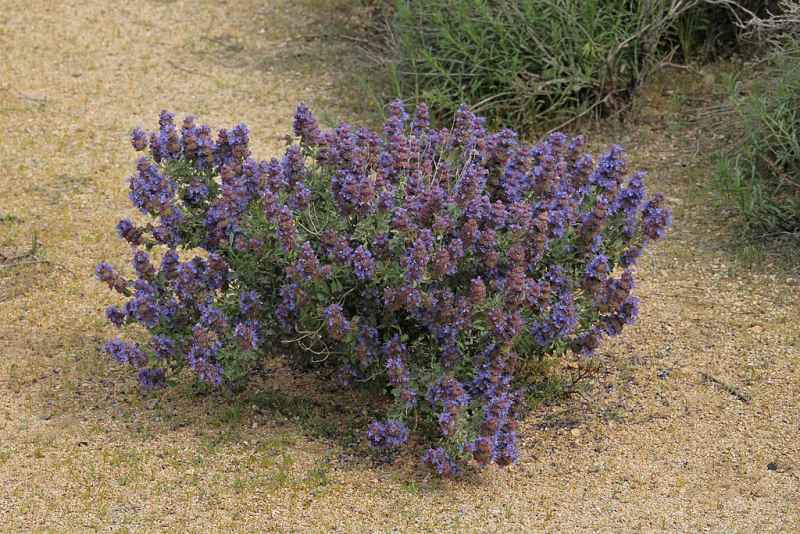
Photo Credit: Walter Siegmund / Wikimedia Commons / CC BY-SA 4.0
Desert sage is another desert landscaping plant well-suited to the arid climate of Nevada. This hardy perennial is native to the western United States and grows in the wild throughout Nevada’s desert regions. Due to its cold hardiness and ability to withstand winter temperatures, it’s particularly well-suited to gardens in Northern Nevada.
This member of the mint family produces clusters of fragrant, pale purple flowers on spikes reaching up to 2 feet. The leaves are an attractive silvery-gray color with a woolly texture, and the shrub’s overall form is compact. Prune it back after the blooming season to encourage new growth and prevent woody stems from forming.
The best time to plant desert sage is in the fall, allowing it to establish its roots before the hot summer months. This drought-tolerant perennial is relatively low-maintenance and requires little water once established – making it an ideal addition to gravel and rock gardens, xeriscapes, and other water-wise landscaping designs.
Growth habit: Shrub
USDA Hardiness Zone: 5-9
Mature size: 1-3 feet tall and 2-4 feet wide
Duration: Perennial
Foliage: Evergreen
Sunlight needs: Full sun
Soil preferences: Thrives in well-drained, dry, chalk, sandy, or loamy soil
Water needs: Low
Potential hazards: Toxic, especially to cats
9. Desert Willow (Chilopsis linearis)
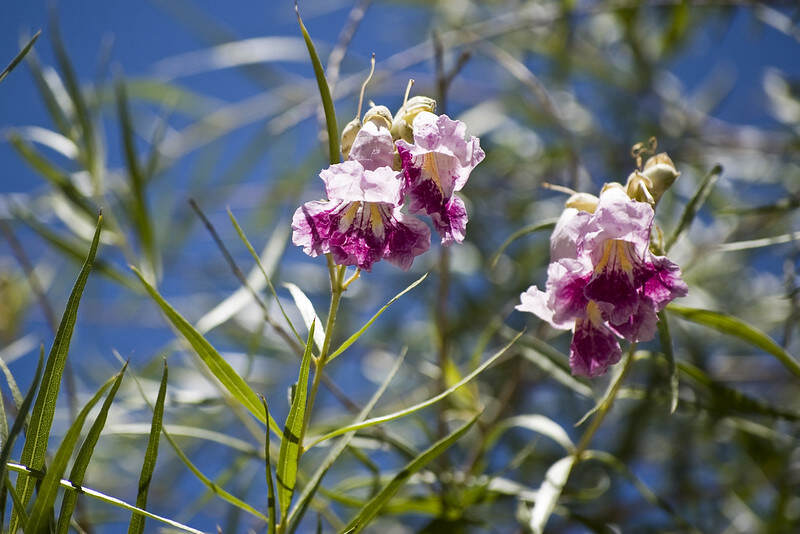
Photo Credit: Ken Bosma / Flickr / CC BY 2.0
Native to the southwestern U.S. and Mexico, desert willow is commonly found in areas with hot, dry summers and mild winters. It can be planted in both northern and southern regions of Nevada, as long as it’s given adequate water and care.
With long, narrow, and willow-like leaves and a light gray bark with a smooth texture, desert willow is a low-maintenance plant that requires low water once established. This beautiful and hardy plant blooms in the late spring or early summer. It produces showy, trumpet-shaped flowers that range in color from pink to purple to white. It is a larval host to several species of butterflies, making it a great addition to a pollinator garden.
Prune it lightly in the winter to promote healthy growth, and water it deeply once a week during the summer months. You also can surround it with other native plants and wildflowers to create a vibrant and diverse landscape.
Growth habit: Shrub or small tree
USDA Hardiness Zone: 7-11
Mature size: 15-30 feet tall, 10-20 feet wide
Duration: Perennial
Foliage: Deciduous
Sunlight needs: Prefers full sun
Soil preferences: Prefers well-drained soil but grows well in most soil types
Water needs: Low
Potential hazards: Non-toxic – but its bark can be poisonous to animals, especially cats
10. Firecracker Penstemon (Penstemon eatonii)
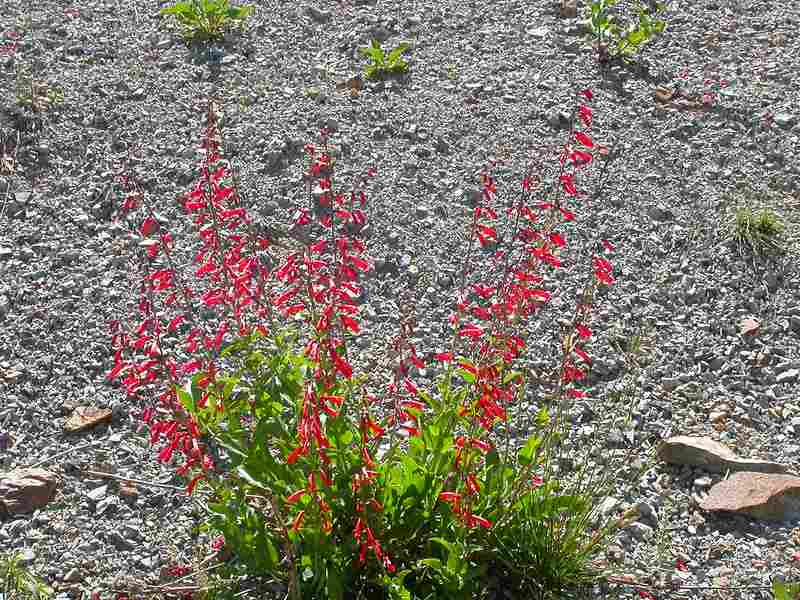
Photo Credit: Matt Lavin / Flickr / CC BY-SA 2.0
Commonly found in the wild in various regions of Nevada, including the Great Basin, Mojave Desert, and Sierra Nevada Mountains, firecracker penstemon can live for many years. Its natural habitat is rocky or sandy soils, often in dry washes, and it’s well-suited for hot, arid climates.
Firecracker penstemon produces striking red-orange flowers that resemble firecrackers, hence the name. Its blooms appear in late spring to early summer and are popular with bees, hummingbirds, and other pollinators.
This drought-tolerant perennial plant has long, narrow leaves with a blue-green hue and a slightly hairy texture. Planting it in well-draining soil and full sun will promote optimal growth and flowering, but you’ll want to deadhead spent blooms regularly. Additionally, pruning the plant back by one-third in the fall will encourage a more compact and bushy habit.
Growth habit: Forb to shrub
USDA Hardiness Zone: 4-8
Mature size: 1-3 feet tall and 1-3 feet wide
Duration: Perennial
Foliage: Semi-evergreen to evergreen
Sunlight needs: Full sun to partial shade
Soil preferences: Prefers moderately well-drained, loamy, or sandy soil
Water needs: Low
Potential hazards: Toxic – can be poisonous, and even fatal, to pets and children
11. Golden Barrel Cactus (Echinocactus grusonii)
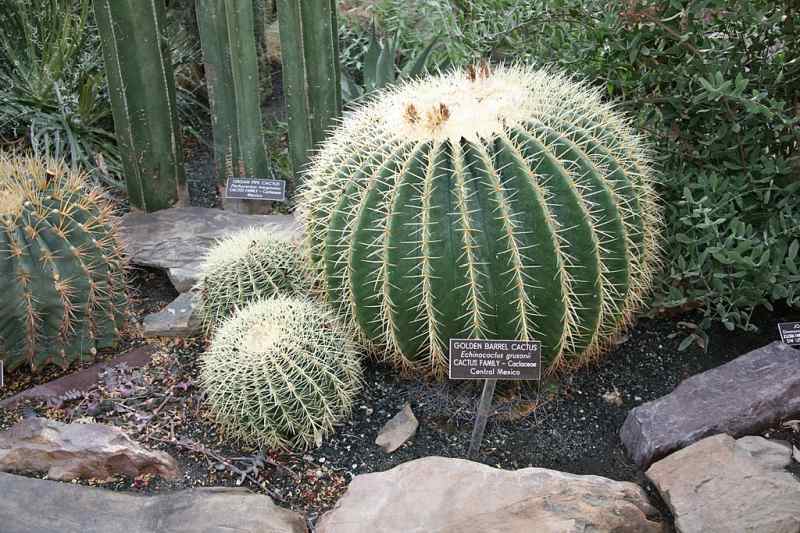
Photo Credit: Cliff from Arlington, Virginia, USA / Wikimedia Commons / CC BY 2.0
Known for its striking appearance and easy maintenance, the golden barrel cactus is commonly planted in xeriscapes and rock gardens in Southern Nevada. This cactus is native to the hot, dry regions of central Mexico, but it is well-suited to the desert climates of Southern Nevada. It can provide shelter for small desert animals, such as lizards and rodents.
Extremely drought-tolerant, golden barrel cactus does not require much watering. In fact, overwatering this succulent can lead to root rot and other diseases. It’s also fairly low-maintenance and does not require much pruning or fertilization. Plus, it can thrive even in dry, rocky soil and produce small, yellow flowers in the summer. With its round, ball-shaped form and golden-yellow spines, it’s a striking addition to any desert landscape.
Growth habit: Cactus or succulent
USDA Hardiness Zone: 9-12
Mature size: 2 feet tall and 2-3 feet wide
Duration: Perennial
Foliage: Evergreen
Sunlight needs: Partial shade to full sun
Soil preferences: Well-drained, loamy, or sandy soil
Water needs: Low
Potential hazards: Toxic – its sap can cause skin irritations and its spines are also harmful
12. Honey Mesquite (Prosopis glandulosa)
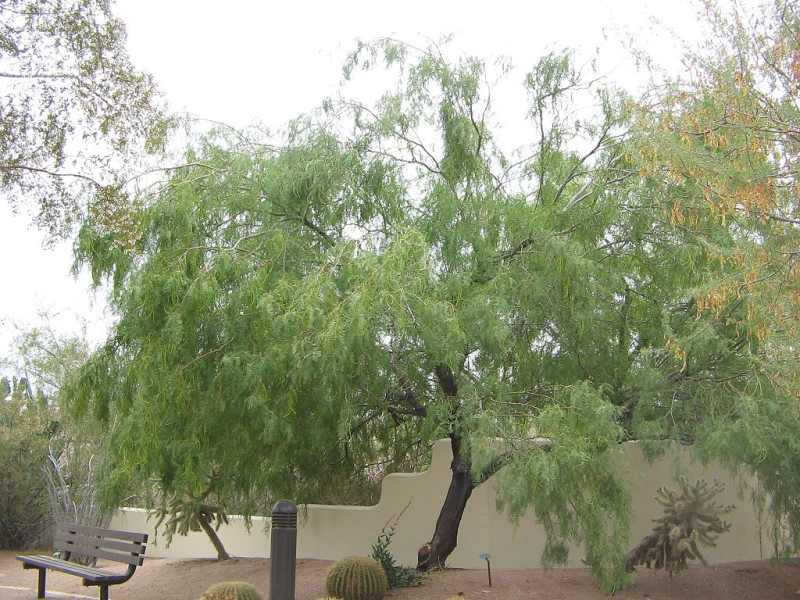
Photo Credit: Don A.W. Carlson / Wikimedia Commons / CC BY-SA 3.0
Native to the Chihuahuan, Sonoran, and Mojave deserts, honey mesquite is well adapted to the hot, dry conditions of Nevada. This hardy, drought-tolerant tree is a staple of the arid Southwest. It can be found in many regions throughout the state, including Southern Nevada, where it’s commonly planted in urban and residential areas.
This deciduous tree blooms from late spring to early summer, producing small, yellowish-green flowers highly attractive to bees and other pollinators. The tree’s leaves are feathery and light green, and its bark is rough and gray-brown. Its long, flat, and brown fruits contain sweet, edible pods that have been used for food by indigenous peoples for thousands of years.
Once established, this perennial plant requires minimal watering – making it a low-maintenance and water-efficient choice for desert landscaping. To make honey mesquite more beautiful in your garden, you can prune it to maintain its shape and promote healthy growth.
Growth habit: Shrub or small tree
USDA Hardiness Zone: 7-9
Mature size: 20-30 feet tall, 25-30 feet wide
Duration: Perennial
Foliage: Deciduous
Sunlight needs: Prefers full sun
Soil preferences: Grows in most soil types but prefers well-drained soil
Water needs: Low – doesn’t need supplemental watering once established
Potential hazards: Can be toxic to animals if consumed in large amounts
13. Joshua Tree (Yucca brevifolia)
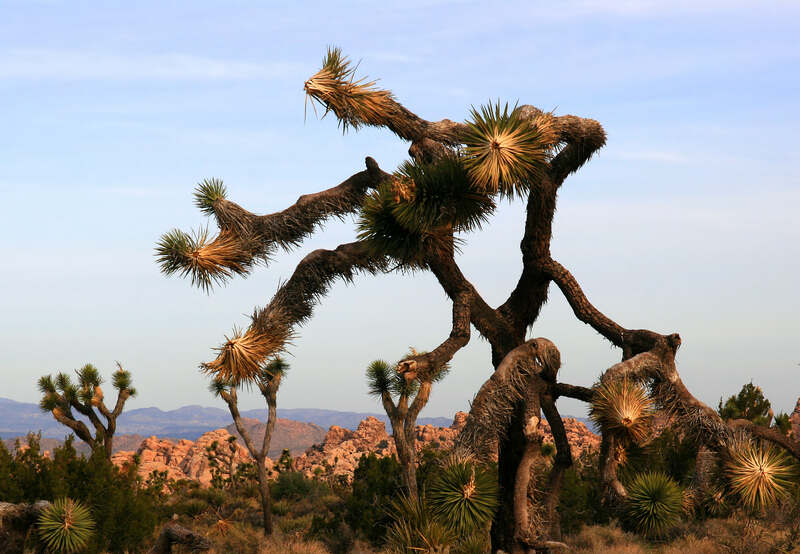
Photo Credit: Brocken Inaglory / Wikimedia Commons / CC BY-SA 3.0
Joshua tree is a unique and iconic plant that thrives in the Mojave Desert. This desert tree is commonly found in the southern region of Nevada, including areas like Las Vegas and the Mojave National Preserve. It’s best suited for landscaping in this region due to its specific habitat requirements.
In the wild, this slow-growing tree can grow more than 30 feet tall and have a lifespan of hundreds of years. With its tall, spiky branches and green, sword-like leaves, the Joshua tree has a distinctive look that makes it seem like an extremely tall person from a distance. It blooms from late winter to early spring, producing large clusters of creamy white flowers that attract pollinators like the yucca moth.
While growing Joshua trees from seeds may be challenging, transplanting young trees can be successful. The best time to plant Joshua trees in a garden is during winter – when temperatures are cooler. It requires low maintenance and little water once established. But you can install low-level lighting to highlight the tree’s unique form and create a stunning nighttime display.
Growth habit: Tree
USDA Hardiness Zone: 6-10
Mature size: 15-30 feet tall
Duration: Perennial
Foliage: Evergreen
Sunlight needs: Full sun
Soil preferences: Dry, well-drained, coarse soil
Water needs: Low
Potential hazards: Toxic – can be severely poisonous
14. Lipstick Echeveria (Echeveria agavoides)
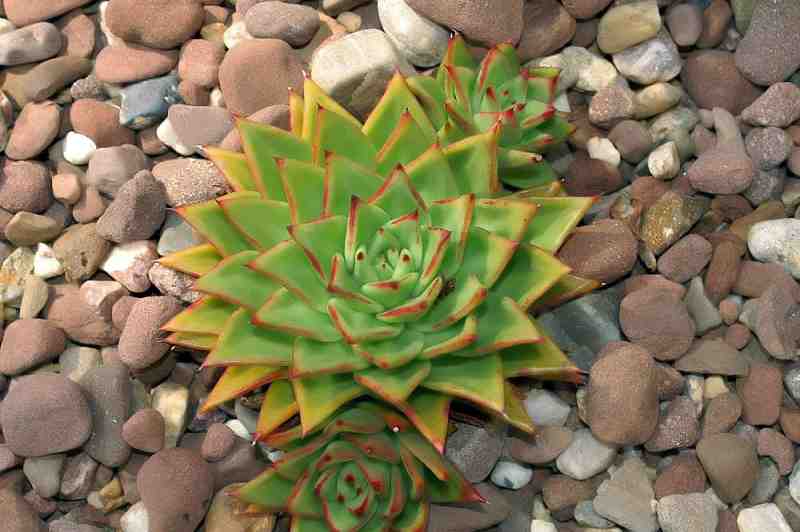
Photo Credit: Photo by David J. Stang / Wikimedia Commons / CC BY-SA 4.0
A popular and stunning succulent, lipstick echeveria is well-suited for desert gardening in both the northern and southern regions of Nevada, as it can tolerate a range of temperatures and soil conditions. This evergreen plant is native to Mexico and is often found growing in rocky areas, making it an ideal choice for gardens with gravel or rocky soil.
This rosette-forming succulent blooms in late spring or early summer with small, bell-shaped flowers in shades of red, orange, or yellow. Its leaves are fleshy and triangular, with a distinct red tip resembling lipstick.
You can propagate it easily from leaf or stem cuttings. But as with most succulents, you must be careful when handling the plant as its leaves can be sharp and may cause skin irritation. Lipstick Echeveria is drought-tolerant and requires little water. It’s relatively disease-free, but watch out for aphids, vine weevil, and mealybugs.
Growth habit: Cactus or succulent
USDA Hardiness Zone: 9-12
Mature size: 6 inches tall and 8-12 inches wide
Duration: Perennial
Foliage: Evergreen
Sunlight needs: Full sun to partial shade
Soil preferences: Grows well in well-drained, rocky, sandy, or loamy soil
Water needs: Low
Potential hazards: Non-toxic – but it’s still not advisable to ingest any of its parts
15. Prickly Pear (Opuntia ficus indica)
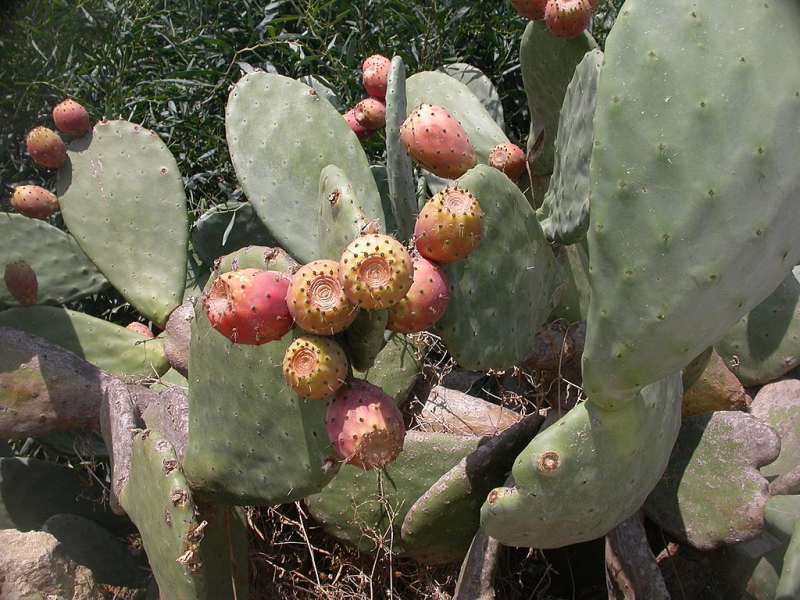
Photo Credit: Mark Burgess / Wikimedia Commons / CC BY-SA 3.0
Also known as Opuntia, prickly pear is one of the most versatile and adaptable succulents ideal for gardens throughout Nevada. This native plant grows wild in many areas across Nevada’s desert landscape, such as the Mojave Desert and the Great Basin Desert. It’s highly resistant to diseases but can be susceptible to mealybugs and cochineal scale.
It has flat, paddle-shaped leaves with spines that grow from the edges. The pads can be green to blue-green, and some even have a purplish tint. In the spring, prickly pear produces beautiful yellow, orange, or red flowers that bloom for several weeks, attracting bees and other pollinators. It’s a larval host for the cactus moth and several species of butterflies.
This perennial succulent can survive in harsh desert conditions with little water, rendering it low maintenance and ideal for homeowners who want a beautiful garden without too much upkeep. It is also drought-tolerant and can store water in its leaves, perfect for xeriscape gardens, hedges, screens, garden beds, and borders that focus on water conservation.
Growth habit: Cactus or succulent
USDA Hardiness Zone: 8-12
Mature size: 10-15 feet tall and 5-10 feet wide
Duration: Perennial
Foliage: Evergreen
Sunlight needs: Full sun
Soil preferences: Prefers well-drained, sandy, or loamy soil but grows well even in dry, rocky soil
Water needs: Low
Potential hazards: Toxic – its fruit is edible but can be poisonous to children and pets
16. Rose Sage (Salvia pachyphylla)
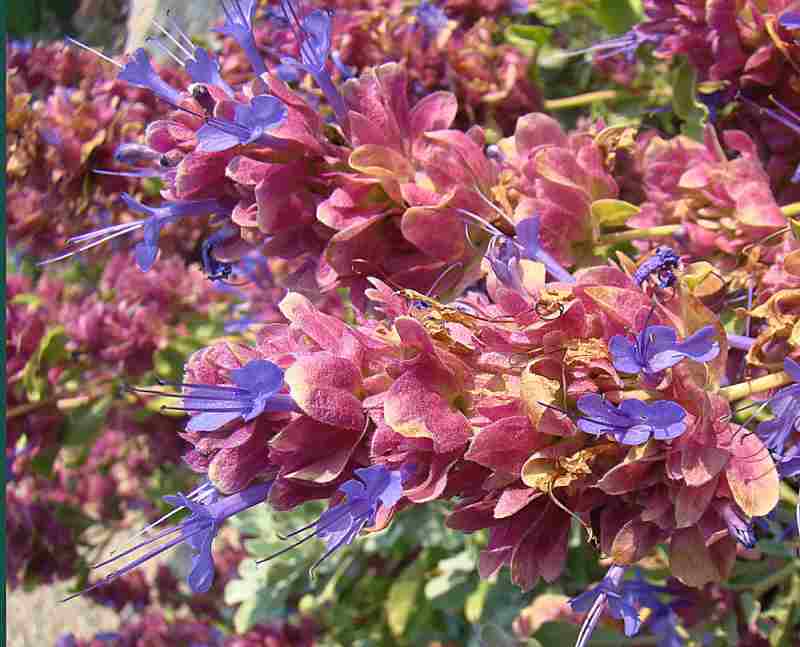
Photo Credit: Dick Culbert from Gibsons, B.C., Canada / Wikimedia Commons / CC BY 2.0
Rose sage is commonly found in the wild, growing on rocky slopes and dry hillsides throughout Nevada. With a natural habitat spanning from Northern Mexico to Southern Utah and California, this evergreen shrub is perfect for desert gardens in Southern Nevada – particularly in the Mojave Desert region, as it thrives in hot, arid conditions.
This perennial plant blooms in the summer and early fall, producing delicate, pink flowers that contrast beautifully against its silvery-green, fuzzy leaves. To grow rose sage, it’s best to plant it in the fall or early spring, allowing it time to establish its roots before the hot summer months. It’s a perfect addition to gravel and rock gardens, patios, containers, and butterfly gardens.
Rose sage requires well-draining soil and can be drought-tolerant once established. However, it benefits from occasional deep watering during prolonged periods of drought. As a desert plant, it does not require much fertilizer and can even thrive in poor, dry soil.
Growth habit: Shrub
USDA Hardiness Zone: 5-9
Mature size: 2-3 feet tall and 2-3 feet wide
Duration: Perennial
Foliage: Evergreen
Sunlight needs: Full sun – but can tolerate shade
Soil preferences: Grows well in well-drained, chalk, loamy, or sandy soil
Water needs: Low to moderate
Potential hazards: Toxic, especially to dogs
17. Sticky Purple Geranium (Geranium viscosissimum)
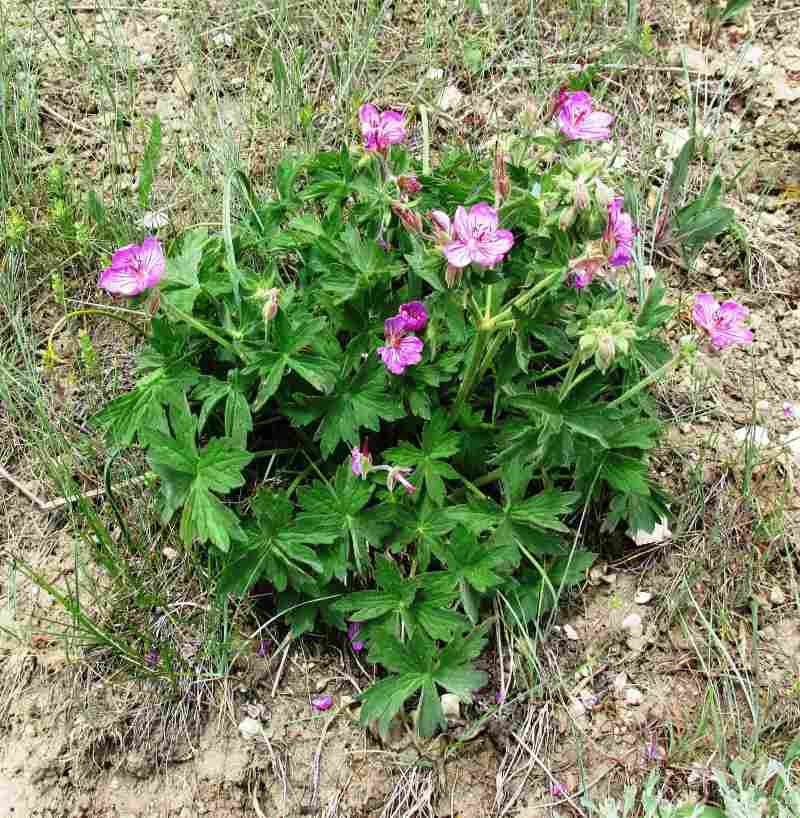
Photo Credit: brewbooks / Flickr / CC BY-SA 2.0
Due to its preference for hot, dry climates, sticky purple geranium is well-suited for gardens in Southern Nevada. Commonly found in rocky, desert areas of the Southwest, this wildflower’s natural habitat is typically in well-drained soils with full sun exposure. It blooms from late spring through summer, producing gorgeous magenta-purple flowers.
The plant’s leaves are deeply lobed and have a sticky texture, hence its name. They are bright green – a great contrast to the striking purple flowers. It’s a relatively low-maintenance plant that’s also highly resistant to diseases and pests. To plant this lovely perennial, the best time is during mild weather in the early spring.
Growth habit: Wildflower
USDA Hardiness Zone: 2-9
Mature size: 1-3 feet tall
Duration: Perennial
Foliage: Deciduous
Sunlight needs: Full sun to partial shade
Soil preferences: Prefers well-drained, dry-mesic to moist, sandy, clay, or loamy soil
Water needs: Low to moderate
Potential hazards: Mildly toxic – geraniums can be poisonous to children and pets
18. Texas Olive (Cordia boissieri)
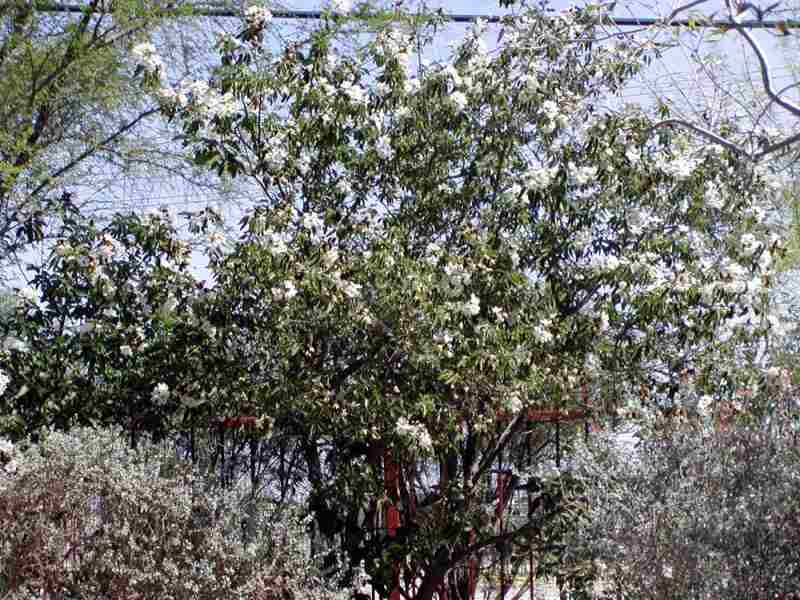
Photo Credit: Stan Shebs / Wikimedia Commons / CC BY-SA 3.0
Also known as Anacahuita or wild olive, Texas olive is a fantastic choice for desert landscaping in Nevada. Although it’s native to South Texas and Mexico, it has adapted well to Nevada’s hot and dry climate. It has glossy, dark green leaves that give it a tropical appearance. It produces fragrant pink and white flowers in the spring and summer, attracting pollinators, such as bees, butterflies, and hummingbirds.
In Nevada, Texas olive is commonly planted in residential landscapes and public spaces, including parks and street medians. It’s tolerant of various soil types and requires little water once established, making it a low-maintenance option for homeowners.
It’s recommended to plant Texas olive in the spring or fall when temperatures are cooler. This way, the plant can establish its roots before the summer heat arrives. Also, prune it to maintain its shape and remove any dead or damaged branches.
Growth habit: Shrub or tree
USDA Hardiness Zone: 9-11
Mature size: 15-30 feet tall, 10-20 feet wide
Duration: Perennial
Foliage: Evergreen to semi-evergreen
Sunlight needs: Full sun to partial shade
Soil preferences: Prefers dry, well-drained, slightly alkaline soil but can thrive even in rocky soils
Water needs: Low to moderate
Potential hazards: Mildly toxic – its raw fruits can be slightly poisonous
19. Utah Agave (Agave utahensis)
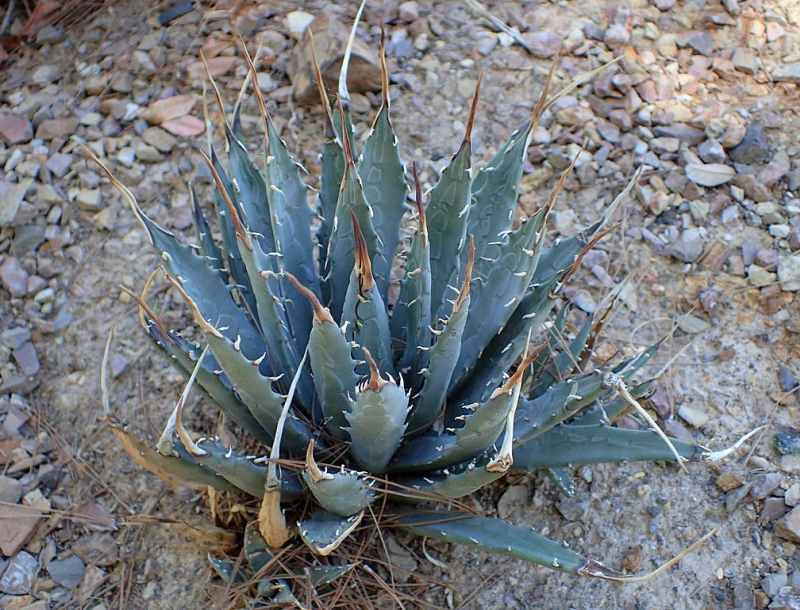
Photo Credit: Krzysztof Ziarnek, Kenraiz / Wikimedia Commons / CC BY-SA 4.0
Utah agave is particularly well-suited to the dry and arid climate of Nevada, as it thrives in hot and sunny conditions. As such, it’s a great option for homeowners throughout the state who are looking to add low-maintenance greenery to their yards. Also known as Utah century plant, this succulent can tolerate a vast range of temperatures.
The plant typically blooms in the late spring or early summer, producing a tall stalk of yellow flowers that can grow up to 20 feet tall. Its bluish-green leaves with spiky, symmetrical shape make it more appealing. This slow-growing plant can take several years to reach maturity, but it’s well worth the wait for its stunning appearance.
Growth habit: Cactus or succulent
USDA Hardiness Zone: 6-10
Mature size: 6-24 inches tall and 1-3 feet wide
Duration: Perennial
Foliage: Evergreen
Sunlight needs: Partial shade to full sun
Soil preferences: Prefers dry, well-drained, neutral to acidic, loamy, sandy, or rocky soil
Water needs: Low – rarely needs watering once established
Potential hazards: Toxic – its sap can be poisonous to both humans and pets, while its needle-sharp spines can be hazardous
What Makes a Plant Good for the Desert?
Since the desert climate presents a huge challenge when it comes to landscaping, it’s crucial to choose the right plants to create a thriving, low-maintenance garden that can withstand harsh environmentals and limited water resources. Consider the following factors to discover if a plant is good for the desert:
✓ Native or desert-adapted: Select plants that are native to the region or have adapted to the arid conditions. These plants are already equipped with the ability to store water, resist drought, and handle high temperatures. They also provide important habitats and food sources for local wildlife.
✓ Low watering needs: Desert plants should be able to thrive with minimal watering once established, reducing the need for excessive irrigation. Look for plants with deep root systems that can access water from lower in the soil profile.
✓ Color: Plants with silver or gray foliage can reflect sunlight and reduce water loss through transpiration, while those with deep green foliage may require more water.
✓ Texture: Plants with spiky leaves or thorns can help deter animals from feeding on them, while softer, more succulent plants may be more vulnerable to damage.
✓ Beneficial: Look for plants that offer multiple benefits, such as providing shade, enhancing air quality, or attracting pollinators. Examples include trees like honey mesquite and blue palo verde, which provide shade while also fixing nitrogen in the soil, and native wildflowers like desert marigold and firecracker penstemon, which attract bees and butterflies while adding bursts of color to the landscape.
By choosing the right desert landscaping plants, you can create a beautiful, sustainable garden that thrives in the unique conditions of your region. Depending on where you live in Nevada, the following information may serve as a guide. Note, though, that these data may still vary since they are just average numbers for each region.
Northern Nevada:
- USDA hardiness zone: 4b-7a
- Average high temperature: 84°F
- Average low temperature: 18°F
- Average rainfall: 7-12 inches
- Common soil type: Sandy or loamy soil with low to moderate fertility
- Other notes: Northern Nevada has a short growing season and experiences cold winters with occasional snowfall. Plants that can tolerate cold temperatures and drought are best suited for this region.
Southern Nevada:
- USDA hardiness zone: 8a-9b
- Average high temperature: 102°F
- Average low temperature: 62°F
- Average rainfall: 4-8 inches
- Common soil type: Sandy or rocky soil with low fertility
- Other notes: Southern Nevada has hot, arid summers and mild winters. For this region, you should choose plants that can tolerate high temperatures, low humidity, and little water.
Central Nevada:
- USDA hardiness zone: 5a-7b
- Average high temperature: 86°F
- Average low temperature: 22°F
- Average rainfall: 4-12 inches
- Common soil type: Rocky or sandy soil with low to moderate fertility
- Other notes: Central Nevada has a continental climate with cold winters and hot summers. Plants that can tolerate extreme temperature fluctuations and dry conditions are ideal for this region.
Western Nevada:
- USDA hardiness zone: 6a-8b
- Average high temperature: 88°F
- Average low temperature: 26°F
- Average rainfall: 8-15 inches
- Common soil type: Sandy or loamy soil with moderate fertility
- Other notes: This region has a semi-arid climate with hot summers and cool winters. As such, choose plants that can tolerate dry conditions and a range of temperatures.
FAQ About the Best Desert Landscaping Plants for Nevada
While palm trees may not be the first that comes to mind when you think of Nevada’s desert climate, they can actually thrive in certain regions of the state. The best region for planting palm trees in the state is Southern Nevada, including the Las Vegas Valley area.
This area has a hot, arid climate, with mild winters and hot summers, making it suitable for planting palm trees. Still, you must choose palm tree varieties that are low-maintenance and drought-tolerant. Some popular varieties for Southern Nevada include Mexican fan palm, date palm, and Mediterranean fan palm.
Yes, there are watering restrictions in place in certain regions of Nevada, particularly in the southern part of the state, due to ongoing drought conditions. The restrictions are designed to help conserve water and ensure that there is enough for essential uses like drinking, sanitation, and firefighting.
In Las Vegas, for example, the Southern Nevada Water Authority has implemented a year-round watering schedule that limits the use of drip irrigation systems and outdoor watering to three assigned days per week based on the property’s address. Additionally, there are restrictions on the time of day when watering is allowed, with no watering permitted between 11 a.m. and 7 p.m. from May 1 to Aug. 31.
Other parts of southern Nevada, including Henderson and North Las Vegas, also have similar watering restrictions in place.
To ensure your Las Vegas landscape remains green and lush, your lawn must be able to withstand the city’s hot, arid climate. Bermudagrass is among the most popular grass types for this area, which is renowned for its drought tolerance and ability to thrive in full sun. This warm-season grass, once established, can survive the sweltering summer heat and cold winters with minimal maintenance.
However, note that certain areas of Nevada, including the Las Vegas Valley, have prohibited the use of non-functional grass through legislation. Homeowners and businesses must replace ornamental turf with water-efficient landscaping or hardscaping.
Non-functional grass is defined as turf that serves no practical purpose or functionality, like grass in medians or large lawns that are infrequently used. The goal of this legislation is to conserve water and encourage sustainable landscaping practices in the area.
Choose the Right Desert Plants for Your Nevada Landscape
When it comes to landscape designs for front yards and backyards in the Nevada desert, choosing the right plants is crucial. From drought-tolerant trees to vibrant succulents, there are numerous options to enhance the beauty and functionality of your outdoor space.
Choose plants that are already adapted to the local climate and soil, so you can save water, reduce maintenance, and enjoy a thriving landscape year-round. With so many desert landscaping plants available, there’s sure to be one that suits your style, budget, and preferences.
Whether you’re living in Las Vegas or another city in Nevada, you should start planning your desert landscape today. Reach out to a landscaping pro for help in creating a beautiful and sustainable outdoor space that you can enjoy for years to come.
Main Photo Credit: Ken Lund from Reno, Nevada, USA / Wikimedia Commons / CC BY-SA 2.0